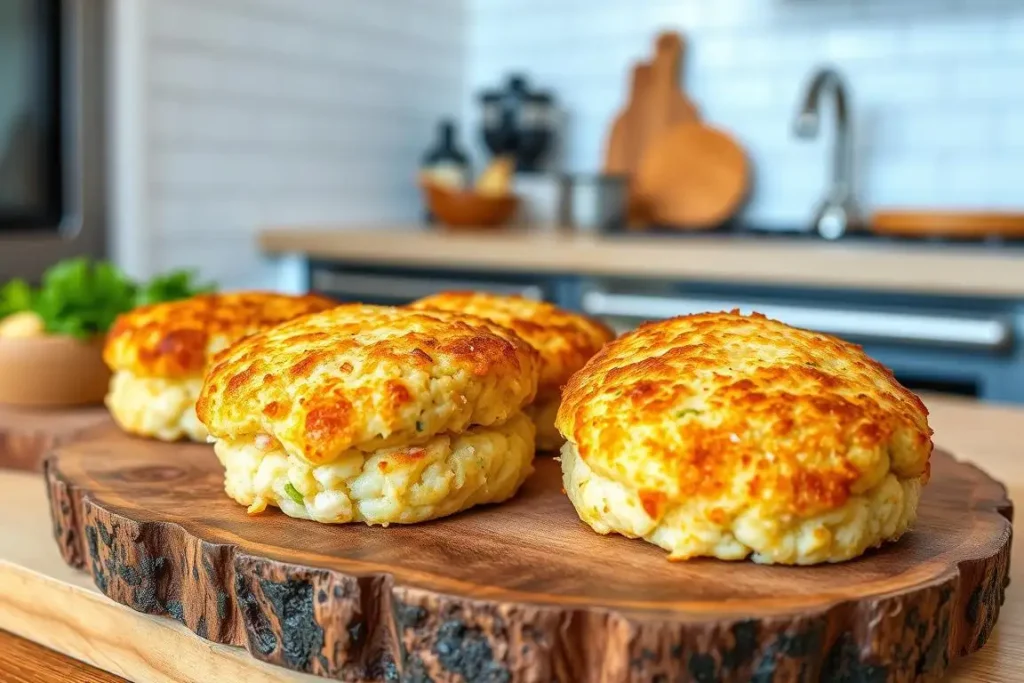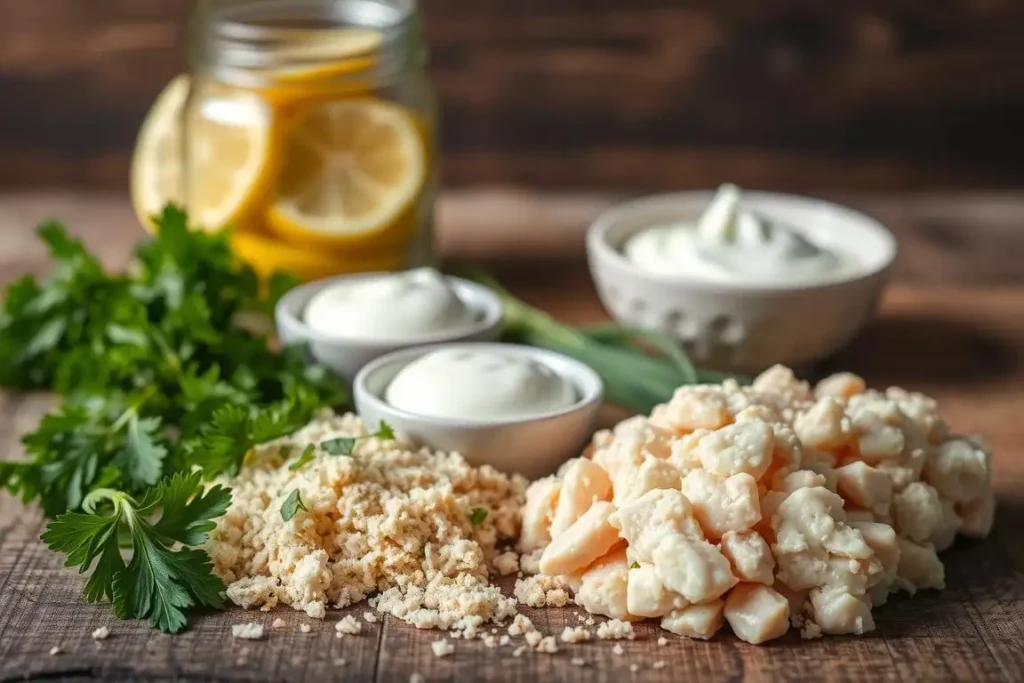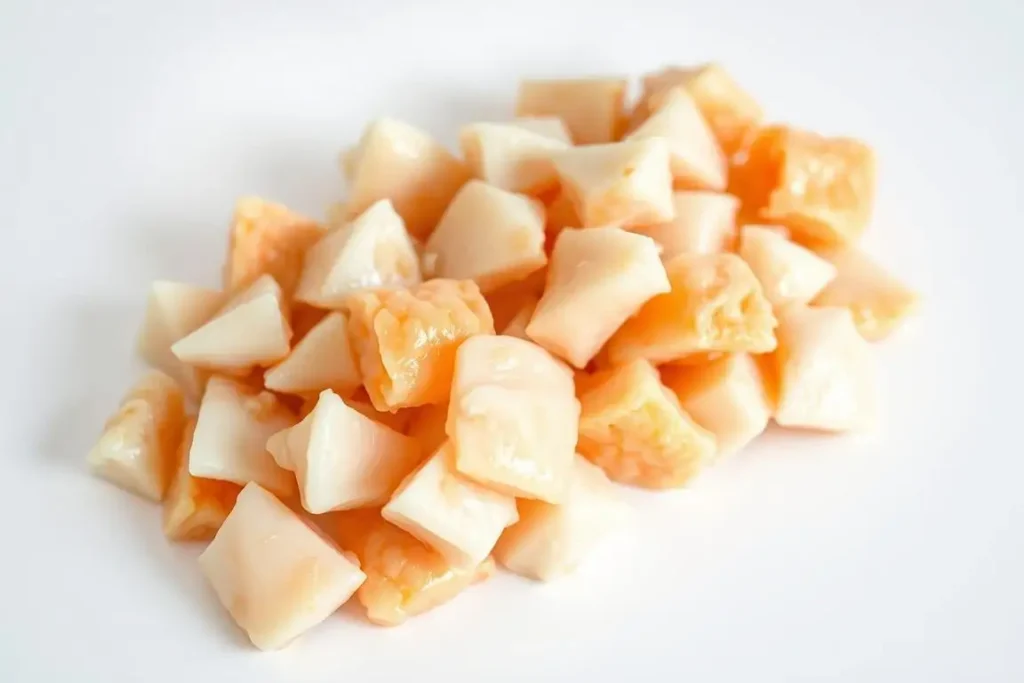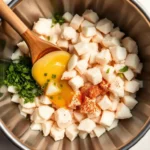Imagine enjoying authentic Maryland seafood flavor without dietary worries. Picture golden-brown cakes filled with sweet crab meat, all without gluten, dairy, or complicated steps. This recipe shows that old traditions and new eating habits can mix well.
Maryland-style seafood dishes are all about simplicity. Our recipe uses just ten pantry staples to highlight the crab. You can bake them for a lighter meal or pan-fry for crispy edges, fitting right into your kitchen routine.
Many worry about changing classic dishes with substitutions. But here, gluten-free breadcrumbs and dairy-free binders work just as well. The result is a dish that pleases everyone, while staying true to Chesapeake Bay traditions.
This recipe is ready in just one hour, perfect for any occasion. You can even air-fry them without oil. With minimal fillers, every bite is a celebration of fresh seafood flavor, just as coastal chefs intended.
Introduction: Why Gluten-Free Crab Cakes {Dairy-Free} Stand Out
Coastal cuisine meets modern dietary needs in this reimagined classic. These patties honor America’s seafood traditions while adapting to today’s nutritional preferences. By swapping conventional binders for alternatives, they achieve the same golden crunch and tender interior that define great crab cakes.

Flavor Without Compromise
Traditional recipes often use breadcrumbs and mayo for texture. Here, gluten-free ingredients like almond flour and dairy-free substitutes replicate the original’s richness. The result is a dish where sweet crab meat is the star, supported by zesty seasonings and a crisp exterior.
Rooted in Coastal History
Maryland’s Chesapeake Bay communities perfected crab cakes generations ago. Local fishermen focused on fresh seafood and minimal fillers—a principle this recipe upholds. “The best versions let the ocean speak,” says a Baltimore chef, emphasizing simplicity.
Today’s adaptations reflect evolving tastes without losing their heritage. Thriving coastal fisheries still supply premium crab meat, ensuring authenticity in every bite. Whether served at family dinners or upscale events, these cakes celebrate America’s love affair with seafood.
Ingredients and Key Components
Building perfect seafood patties starts with understanding how each component contributes to texture and taste. Every ingredient plays a specific role – binding agents keep the mixture intact, while spices enhance the natural sweetness of the star protein.

Essential Ingredients for Authentic Flavor
Lump crab meat is the base, giving tender bites. A single egg holds it together, and gluten-free breadcrumbs add structure. The secret is in the seasoning: Dijon mustard and Worcestershire sauce add tanginess, while Old Bay spice mix brings the iconic flavor.
Fresh parsley and lemon juice make the flavors pop. Quality mayonnaise moistens and enriches the mix. Avocado oil-based versions are healthier than traditional fats.
Substitute Options for Dietary Needs
Plant-based mayonnaise keeps it creamy for dairy avoiders. Smart Balance butter substitutes work well for brushing before baking. Always check labels to ensure the seasoning meets dietary needs.
Aquafaba (chickpea liquid) is a great egg substitute. Avocado oil is safe for high heat, making the exterior crispy. These swaps let everyone enjoy coastal flavors without dietary worries.
Selecting the Right Crab Meat
Choosing premium seafood makes ordinary patties into coastal delicacies. The texture and sweetness of your dish depend on understanding crab meat grades. Each variety offers unique qualities that impact both presentation and flavor.

Jumbo Lump vs. Lump vs. Backfin: Understanding the Differences
Jumbo lump features snow-white chunks from the crab’s swimming muscles – the priciest option with firm, meaty bites. Perfect for showcasing whole pieces in upscale presentations. Lump meat provides smaller but equally sweet morsels, ideal for maintaining structure in patties without breaking the bank.
Backfin blends flaky fragments with occasional lump pieces, creating a tender base at lower costs. While claw meat adds bold flavor to soups, its darker color and fibrous texture don’t suit delicate cakes. “Mixing lump and backfin gives you chunky texture and budget flexibility,” notes a Chesapeake Bay cook.
Tips for Sourcing Fresh Crab Meat
Seek refrigerated containers from trusted fish markets or grocery seafood counters. Fresh meat smells clean like the ocean – avoid anything with sour notes or cloudy liquid. Bright white color indicates proper handling, while yellow tints suggest aging.
Check packaging dates and plan to cook within 48 hours. Gently sift through meat before mixing to remove stray shells. For peak quality, store at 34°F and avoid temperature fluctuations. Premium options might cost more, but they elevate your recipe from good to unforgettable.
Preparing and Chilling the Crab Mixture
The secret to perfect seafood patties lies in how you handle the mixture before cooking. Proper technique ensures each bite stays tender while developing balanced flavors.

Mixing Ingredients Gently to Preserve Texture
Start by whisking wet ingredients in a large bowl – egg, mayo, and zesty seasonings form the flavor base. Layer fresh parsley and breadcrumbs over this mixture before adding the star ingredient. This stacking method protects delicate chunks during blending.
Use a rubber spatula to fold everything together like you’re handling clouds. “Overmixing turns premium meat into mush,” warns a Chesapeake Bay cook. Aim for just 8-10 folds – you’ll see streaks of seasoning clinging to lump pieces.
Chill the combined mixture for at least 30 minutes. This resting time lets breadcrumbs absorb moisture, creating a firm texture that holds shape during cooking. For best results, refrigerate overnight. Cold temperatures tighten the bind while letting spices meld.
Cover the bowl tightly with plastic wrap to lock in freshness. When ready, portion chilled mixture using an ice cream scoop for even sizing. Gentle handling at every stage guarantees patties that stay intact without sacrificing that prized tender bite.
Cooking Methods: Baked vs Fried Options
Your cooking technique shapes both flavor and texture in this coastal favorite. Baking offers a lighter approach, while frying delivers that iconic crunch. Let’s explore how each method impacts results.
Baked Method Details for a Healthier Option
Preheat your oven to 450°F. This high heat makes the edges golden without drying the inside. Lightly brush patties with melted plant-based butter for better browning.
Bake for 15-20 minutes until they hit 165°F inside. This method uses little oil, great for health-conscious cooks. The dry oven crisps the breadcrumbs while keeping the seafood tender.
“Baking lets delicate flavors shine,” says a Maryland chef.
Fried Method Tips for Extra Crispiness
Heat 4 tablespoons of avocado oil in a skillet over medium heat. Add patties when the oil is shimmering. Fry 3-5 minutes on each side until they’re amber-brown.
Proper oil temperature is key to avoid sogginess. Test with a breadcrumb. If it sizzles right away, you’re good to go. Drain cakes on paper towels to remove extra oil.
This method gives you a restaurant-style texture but requires careful flipping.
Step-by-Step Recipe Instructions
Consistent sizing and proper technique are crucial for restaurant-quality results. Follow these guidelines to make golden-brown delights that hold their shape while cooking.
A Recap of Key Steps for Easy Follow-Along
Start by lining your baking sheet with parchment paper. Lightly coat it with cooking spray to prevent sticking. Use a ½ cup measuring cup to portion the mixture for even cooking times.
Gently scoop six mounds onto the prepared surface. For baked versions, keep them rounded to retain moisture. Press lightly with damp hands to compact without crushing delicate chunks. Fried patties need flattening into ¾-inch discs for optimal crispness.
Bake at 450°F for 15 minutes until edges turn amber. If pan-frying, heat oil until a breadcrumb sizzles on contact. Flip cakes carefully using a thin spatula. Let rest 2 minutes before serving – this helps them firm up beautifully.
This recipe adapts to your preferred method while delivering coastal flavors in every bite. Whether baked or fried, uniform portions guarantee professional results perfect for weeknights or special occasions.
FAQ
Can I use canned crab meat instead of fresh?
Fresh jumbo lump or lump varieties are ideal for texture, but canned works in a pinch. Drain excess liquid thoroughly to avoid a soggy mix. Opt for high-quality brands packed with minimal additives.
How do I prevent the patties from falling apart during cooking?
Chill the mixture for at least 30 minutes before shaping. Use gluten-free breadcrumbs and a binding agent like egg. Handle the meat gently to maintain its natural structure.
What’s a good substitute for mayonnaise in a dairy-free version?
Avocado oil mayo or vegan alternatives work well. For a lighter option, try mashed avocado blended with a touch of lemon juice for acidity.
Can I prepare the mixture ahead of time?
Yes! Store the uncooked blend in an airtight container for up to 24 hours. Shape and cook when ready. This helps flavors meld and improves texture.
What’s the key difference between baking and frying?
Baking offers a lighter, crisp exterior using minimal oil. Frying creates a golden, crunchy crust. Both methods retain moisture if cooked at the right temperature.
How long do leftovers stay fresh?
Cooked patties keep for 2–3 days refrigerated. Reheat in an oven or air fryer to restore crispness. Freeze uncooked portions for up to 1 month.
Dairy-Free Crab Mixture
Equipment
- 1 Mixing Bowl Medium-sized, glass preferred
- 1 Spoon For stirring ingredients
- 1 Fork To flake crab pieces
Ingredients
- 1 cup Imitation crab Flaked dairy-free if available
- 1/4 cup Dairy-free mayo Use soy- or avocado-based version
- 1 tbsp Celery Finely chopped
- 1 tsp Dijon mustard
- 1 tsp Lemon juice Freshly squeezed
- 1 tbsp Green onion Chopped
- 1/4 tsp Garlic powder
- — — Salt and pepper To taste
Instructions
- Flake the imitation crab with a fork until it reaches desired texture.
- | 2 | Combine crab, mayo, celery, mustard, lemon juice, green onion, and garlic powder in a mixing bowl. |
- Stir well until the mixture is smooth and evenly combined.
- Season with salt and pepper to taste.
- Chill for 10 minutes before serving for best flavor.


